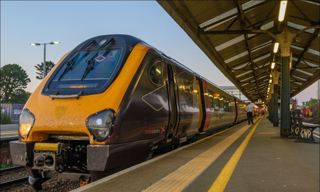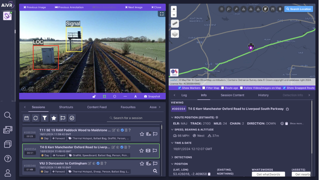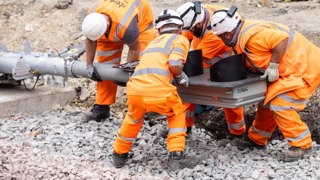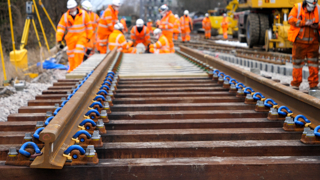
The chairman of open access operator Go-op is confident that the company will be a success, as it looks to raise around £2 million in start-up costs with the aim of starting services in 2026.

The chairman of open access operator Go-op is confident that the company will be a success, as it looks to raise around £2 million in start-up costs with the aim of starting services in 2026.
Go-op was given the go-ahead by the Office of Rail and Road in mid-November to start running trains between Swindon, Taunton and Weston-super-Mare.
Chairman Alex Lawrie was “over the moon”, telling RAIL: “It has been such a long journey to get to this point. I am fully aware that ORR approval does not mean that we’re actually running any trains, and they’ve set us some fairly stiff conditions that we have to comply with, but even so it represents a real breakthrough moment for us.
“This is the point at which a completely independent, completely grassroots, co-operative project has actually met with the approval of the rail regulator.”
ORR has approved return trips from Taunton-Swindon (four), Taunton-Westbury (three), Frome-Westbury (two), and Taunton-Weston-super-Mare (two).
Go-op had hoped to start as early as December 2025, but 2026 is now the realistic goal.
Lawrie said Go-op’s service will be about serving market towns which “have a very limited rail service”, highlighting cross-country journeys which have poor connections such as Swindon- Salisbury, and the struggle to travel into Taunton from various Somerset towns.
He recounted his own experiences of living in Yeovil in 2004, and finding that there were “hardly any trains leaving Pen Mill”.
After seeing other co-operative projects take off, he thought: “When you stop and think about it, there’s absolutely no reason that a group of frustrated rail passengers couldn’t start their own co-op.”
The operator has around 300 members, but Lawrie hopes this will reach five figures - including some of the hundreds of thousands of passengers he expects Go-op to carry.
It has used the MOIRA demand forecasting system that takes existing ticket sales to predict how behaviours will change, although Lawrie admitted that on some routes there is “almost no travel by rail”.
As a result, staff have built a gravity model to look at the attractiveness of two settlements and the nature of the journey between them, to forecast how many people would use it.
“There are still a lot of unknowns,” Lawrie acknowledged. He said Go-op’s plans “conservatively” estimated no more COVID recovery, although housing developments that are either underway or due to happen at places such as Bridgwater, Frome and Melksham could also lead to new customers.
Great Western Railway opposed Go-op’s plans due to “significant” revenue abstraction concerns.
ORR and Go-op forecasted revenue abstraction of around £700,000 in the third year of operations. But Lawrie also predicted that GWR would “do rather well” with the new operator contributing to station running costs, as well as projections that a proportion of new passengers who transfer from Go-op to GWR services would lead to the latter “making anything up to £1 million a year out of that”.
GWR also voiced concerns about train paths, highlighting the eight-and-a-half-mile single-track section between Staverton and the Great Western Main Line near Chippenham as a potential bottleneck.
GWR Network Access Manager Rob Holder, wrote: “GWR has not always been able to expand its service on the route because of this. In addition, engineering work (or perturbation) on the Berks and Hants leads to diversion via this route, such that at times the GWR local service has had to be lifted to leave reliable capacity for these diverted services.”
Lawrie described that stretch as “the single biggest timetabling challenge on the route”, which has limited them to five return services going all the way to Swindon. However, he said the 2022 advanced timetable study for the Westbury area left a “Go-op- shaped hole” which is “ready to be filled”.
Before any trains can run, ORR’s non-negotiable condition of upgrading eight level crossings must be met, after Network Rail identified increased safety risks. With an estimated cost of £1m-£1.5m, it’s Go-op’s largest start-up cost.
NR has said it will work with Go-op and other users of the Melksham line to “assess the implications - including capacity and level crossing enhancements
- and agree a way forward”, while GWR said it “recognises any additional services have the potential to bring choice and looks forward to welcoming any improvements to the network”.
Initially, Go-op plans to run Class 153s, but the long-term aspiration is battery-powered units.
The ‘153s’ are understood to come from Transport for Wales as they go off-lease. Go-op could start with four units (a single-car unit, a two-car diagram, and a spare), although the plan is for a fleet of seven.
The operator is looking at Thingley Junction (near Chippenham) and Taunton station for stabling the units, although other options are being considered.
The ‘153s’ will be operated by a team of mostly new drivers, with the first cohort set to enrol and begin training in early 2025.
“Clearly if we went out and simply recruited skilled drivers to join our team, I think we would be very unpopular with other operators - and rightly so, because there is a shortage of drivers out there,” said Lawrie.
However, he added that at least two experienced drivers and a driver instructor will be required.
In total, Go-op estimates needing around 30 staff, with around two-thirds being train crew. Over the coming months more staff will be recruited, such as an operations director.
There will also be a public offer of community shares being launched in December, and potential loans, while level crossing improvements are also being costed.
Lawrie is confident the operation will be a success: “We have satisfied ourselves that although there is going to be a slow build up, and people don’t change their travel habits overnight, there is enough of a potential market there for us to make a comfortable living.
“Somone described our route as nowhere to nowhere, which I think is a little harsh, but it’s quite deliberate on our part to choose a route which serves underserved stations.
“That’s because we recognise these towns do have a significant population who do need to travel, and they’ve been kind of missed out.”
Login to continue reading
Or register with RAIL to keep up-to-date with the latest news, insight and opinion.















Login to comment
Comments
No comments have been made yet.